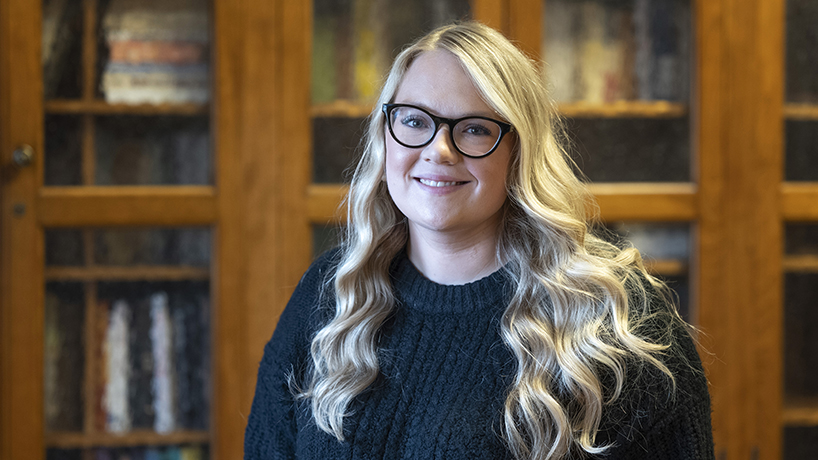
For her DNP clinical scholarship project, “Evaluating Loneliness in an Older Adult Population,” graduate Kelli Rowland developed a tool to objectively measure the impact of the Visit-A-Bit program, which aims to reduce feelings of loneliness in older adults. (Photo by August Jennewein)
Getting through the Doctor of Nursing Practice program at the University of Missouri–St. Louis required Kelli Rowland to balance the demands of school with her work in the cardiac stress lab at SSM Health St. Clare Hospital – Fenton.
That was difficult enough, but school became even more demanding when Rowland began her clinical scholarship project.
“To quote Dr. Laura Kuensting, a professor at the College of Nursing, this project is like an elephant in the room, and you have to eat the elephant,” she said. “You think you’re never going to be able to eat that elephant, but if you go slowly, bite by bite, you will get through it.”
Rowland finished the elephant and her DNP this semester and will graduate this month. Though she’ll be leaving UMSL, her project, “Evaluating Loneliness in an Older Adult Population,” will have lasting influence both through its direct impact and through the creation of a relationship between the College of Nursing and Visit-A-Bit.
The program from the Visiting Nurse Association of Greater St. Louis, or VNA, connects volunteers with senior adults to provide companionship in the St. Louis area. Volunteers commit to the program for at least nine months, visiting an assigned senior adult one-to two hours a week and touching base by phone periodically. Seniors also have the option to participate in additional activities, such a tele-bingo.
The program is designed to reduce feelings of loneliness, which doesn’t only increase the likelihood of developing mental health problems, such as depression and insomnia, but can also negatively impact physical health, including an increased risk of cardiovascular or cerebrovascular problems and higher risk for nursing home admission.
A peer connected Rowland with Visit-A-Bit, and immediately, she felt a connection to the program’s mission.
“I just love the idea of this program,” she said. “I saw it personally in my grandma after my grandpa passed away. It’s been 10-plus years ago at this point, and she’s lonely. We try to meet up with her as much as we can, but I see, even just as a person outside of my career, how hard it is on her, especially with the pandemic.”
Visit-A-Bit needed a new screening tool to figure out quantitatively if the program was working and also to determine if incoming senior adults could be helped. As a nonclinical program, Visit-A-Bit doesn’t help address heavy depression or memory loss.
“We needed a tool to help show impact, if there’s any change,” Visit-A-Bit Manager Michele Prevedel said. “Loneliness is subjective in the sense of it’s an emotional feeling. How do you measure that?”
Rowland began by examining the tool Visit-A-Bit already had in place and looking for evidence-based research on what worked. Specifically, she searched for protocols that were shown to be objective, geared toward older adults and not too lengthy.
She included questions from the De Jong Gierveld Loneliness Scale, the Lubben Social Network Scale–6, the Patient Health Questionnaire-2, a depression screening, and a few subjective questions, such as if there were a certain time of day individuals felt especially lonely, and questions related to social determinants of health, such as access to transportation and food accessibility.
After getting approval for the questionnaire, Rowland implemented it between November 2020 and May 2021. When she analyzed her results, she found that objective and perceived quality of life and objective loneliness were improved, though perceived loneliness did not change.
“I was really excited because you do these projects, and you don’t know what’s going to happen at the end,” Rowland said. “It was really exciting to see that those two things changed because that’s kind of the point – the whole project revolved around quality of life and loneliness.”
Visit-A-Bit continues to use the tool, and a new UMSL DNP student has started working with the program to implement mindfulness programs, which have been shown to help reduce loneliness.
Rowland hopes that this is the start of a long relationship between UMSL and Visit-A-Bit.
“I really hope that this could help keep DNP students going to the VNA every year because they really need the help there,” she said. “I helped them but they helped me also – it’s a symbiotic relationship. It was really an amazing thing, being able to talk to the people. I don’t think everybody is lucky enough to have a project where they actually love it as much as I did.”
Going forward into her own practice, Rowland would like to continue doing research and implementing the results.
She also hopes to continue in school – as a teacher.
“This whole experience was awesome,” Rowland said. “I want to come back and mentor people through the process because it’s both rewarding and challenging. Completing this degree is the biggest thing I’ve ever done in my life so far. I’m very excited to graduate and start the next part of my journey.”
Individuals interested in volunteering with Visit-A-Bit can learn more on its website.














